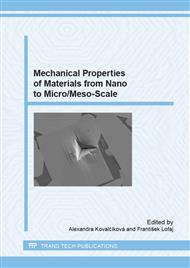[1]
CEB-FIB Model Code for Concrete Structures 2010, fib - International Federation for Structural Concrete, Ernst & Sohn, Berlin, (2013).
DOI: 10.35789/fib.bull.0002
Google Scholar
[2]
G. Rombach, Application of Finite Element Method in Structural Concrete (In German: Anwendung der Finite-Elemente-Methode im Betonbau), Ernst & Sohn, Berlin, (2007).
DOI: 10.1002/stab.200001630
Google Scholar
[3]
J. Červenka, V. K. Papanikolaou: Three dimensional combined fracture-plastic material model for concrete. Int. J. Plasticity. 24(12) (2008) 2192-2220.
DOI: 10.1016/j.ijplas.2008.01.004
Google Scholar
[4]
J. Kralik, J. Kralik, Seismic analysis of reinforced concrete frame-wall systems considering ductility effects in accordance to Eurocode, Engineering Structures 31(12) (2009) 2865-2872.
DOI: 10.1016/j.engstruct.2009.07.029
Google Scholar
[5]
O. Sucharda, D. Mikolášek, J. Brožovský: Determination of Concrete Cube Strength from used Samples. Transactions of the VŠB - Technical University of Ostrava 12(2) (2012) 186–194.
DOI: 10.2478/v10160-012-0033-3
Google Scholar
[6]
O. Sucharda, J. Brozovsky, D. Mikolasek, Numerical modelling and bearing capacity of reinforced concrete beams, Key Engineering Materials 577-578 (2014) 281-284.
DOI: 10.4028/www.scientific.net/kem.577-578.281
Google Scholar
[7]
ATENA Program Documentation, ATENA Studio. Cervenka Consulting, 2013. Information on http: /www. cervenka. cz.
Google Scholar
[8]
Computer Pragram FReET (Computer Pragram for Statistical, Sensitivity and Probabilistic Analysis): Theory Manual. Brno, (2002).
Google Scholar
[9]
K. Reißen, J. Hegger, Experimental investigations on the effective width for shear of single span bridge deck slabs, Beton- und Stahlbetonbau 108(2) (2013) 96-103.
DOI: 10.1002/best.201200064
Google Scholar
[10]
J. Kortis, The stress analysis of the industrial fiber-reinforced concrete slab on elastic subgrade loaded by the operational loading, Applied Mechanics and Materials 617 (2014) 46-49.
DOI: 10.4028/www.scientific.net/amm.617.46
Google Scholar


